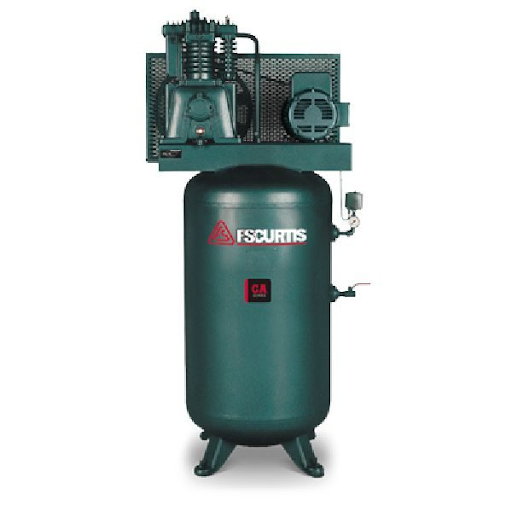Air compressor tanks are essential for efficient compressed air systems. They serve as storage containers, holding compressed air and ensuring a continuous flow of tools and machinery. Without the right-sized tank, your system may experience pressure changes and decreased performance.
Proper tank sizing has multiple benefits:
- Improved system efficiency
- Lower operating costs
- Extended equipment lifespan
By reducing compressor cycling and minimizing equipment wear, you can prolong the life of your compressor unit and reduce energy usage.
Evaluating your current setup and adjusting the tank size accordingly can lead to improved performance and substantial financial savings.
Consider exploring R-Series Air Compressors for efficient solutions. These compressors offer a range of horsepower options to suit different needs.
Additionally, for those in need of high-quality drying elements, the HDF Series Single Tower is worth considering. These drying elements provide exceptional moisture removal capabilities, with dew points as low as -40°F.
With the right combination of compressor and drying elements, you can optimize your compressed air system for maximum efficiency and longevity.
Understanding the Role of Air Compressor Tanks
Balancing Air Supply and Demand
Air compressor tanks, also known as air receiver tanks, are essential for maintaining a balance between the amount of air being produced by the compressor and the amount being used by various tools and equipment in a compressed air system. These tanks store excess compressed air when demand is low and release it when demand increases, ensuring a consistent supply of air during peak usage periods. This process helps prevent the compressor from constantly turning on and off, which can cause it to wear out quickly.
Minimizing Pressure Fluctuations
One of the main purposes of an air compressor tank is to reduce pressure fluctuations and smooth out the airflow in a system. When air is compressed, it creates pulses or surges of pressure that can affect the performance of pneumatic tools and machinery. An air receiver tank acts as a buffer, absorbing these pulses and delivering a more steady stream of air to the connected devices.
Ensuring Dry Air Quality
Air receiver tanks are often equipped with mechanisms for removing moisture from the compressed air system. When air is compressed, its temperature rises, causing water vapor to condense into liquid form. If this moisture is not effectively drained out, it can mix with the compressed air and cause problems such as corrosion in the equipment or contamination of end-products. By having proper drainage systems in place, these tanks help maintain dry air quality throughout the system.
For those looking for more advanced options in compressor systems, resources such as oil-free compressors or NX-Series(4-185 kw) offer valuable insights into specialized equipment that can complement your existing setup.
Understanding these key roles played by air compressor tanks will enable you to choose the right tank size and design for your specific needs. This knowledge is crucial for making informed decisions about optimizing your compressed air system’s performance and durability.
Signs that Your Air Compressor Tank is Undersized
Frequent cycling and reduced tool performance are common indicators that your air compressor tank might be undersized. When the tank cannot store enough compressed air to meet demand, the compressor is forced to cycle on and off more frequently. This not only strains the compressor but also leads to inefficient energy usage and potential downtime.
Common Indicators of an Undersized Tank
- Frequent Cycling: The compressor turns on and off more often than expected.
- Reduced Tool Performance: Air tools or machinery may not operate at their full capacity, leading to subpar performance.
- Excessive Wear and Tear: The constant cycling can accelerate wear on the compressor unit, potentially reducing its lifespan.
Importance of Calculating the Right Tank Size
Calculating the correct tank size based on CFM (Cubic Feet per Minute) requirements is crucial for optimal performance. An undersized tank won’t be able to maintain the necessary air pressure, thereby affecting the efficiency of your entire system.
To determine the ideal tank size:
- Identify the tool with the highest CFM requirement at the required PSI.
- Multiply that CFM requirement by 1.25 or 1.5.
- Round up to the closest gallon size.
For instance, if your tool requires 10 CFM at 90 PSI, you should be looking at a tank capable of handling between 12.5 to 15 CFM.
For more complex systems or larger applications, such as those involving CA Series(5-15 hp) or SP20-Series(175-300 hp), consulting with a qualified engineer is advisable to ensure proper sizing and system design.
By accurately sizing your air compressor tank, you ensure a balanced air supply, which helps in maintaining consistent performance and prolonging equipment life.
Sizing Considerations for Optimal Performance
Formula for Sizing Air Compressor Tanks
To select the right air compressor tank size, you need to understand the formula for sizing tanks based on volume and pressure needs. The basic formula takes into account the tool with the highest CFM (Cubic Feet per Minute) requirement at the required PSI (Pounds per Square Inch).
- Identify the highest CFM requirement of your tools.
- Multiply that CFM by a factor of 1.25 to 1.5 to ensure a buffer.
- Round up to the nearest gallon size.
Following this approach provides a buffer against peak demands, ensuring your air compressor operates efficiently.
Other Factors Influencing Tank Performance
Several additional factors can affect tank performance:
- Pipe/Hose Size and Length: Longer pipes or hoses can cause pressure drops, impacting overall system efficiency. Larger diameter pipes help mitigate these drops, maintaining consistent air pressure.
- Volume/Pressure Variations: Fluctuations in air consumption require careful consideration of both volume and pressure variations. Properly sized tanks balance these variations, preventing system strain.
For more detailed information on selecting the appropriate air compressor, you might find these reciprocating air compressors or rotary screw air compressors from FS Curtis helpful.
Proper sizing ensures optimal performance, reducing wear and tear on your equipment and extending its lifespan.
Choosing the Right Air Compressor Tank Size for Your Needs
When it comes to selecting the appropriate air compressor tank, several factors need careful consideration in order to ensure safety and efficiency. One such critical component is the pressure relief valve. This valve plays a vital role in maintaining safety by automatically releasing air if the pressure exceeds safe limits. Without it, excessive pressure could lead to dangerous situations, potentially damaging equipment and causing injury.
Additionally, it’s important to consider the presence of effective drainage and drying elements in the tank. Air receiver tanks often accumulate moisture, which can degrade air quality and damage tools. Tanks equipped with proper drainage mechanisms help remove this moisture, ensuring dry air quality and preventing corrosion. Drying elements further enhance this process by eliminating residual humidity, fostering a more reliable and efficient system.
Factors to Consider When Choosing an Air Compressor Tank Size
Aside from these critical features, there are other factors that should be taken into account when selecting your tank size:
- CFM requirements: It is essential to ensure that the tank can handle peak air demand. This means considering the required Cubic Feet per Minute (CFM) output of your tools or machinery.
- Application-specific needs: Different tools and industries may necessitate varying tank capacities based on their specific requirements.
For those seeking high-performance options with advanced features tailored to diverse industrial applications, exploring product ranges like the NXHE-Series (90-260 kw Two-Stage) at Aircomo would be worth considering.
Exploring the Advantages of Larger Air Compressor Tanks
Larger air compressor tanks offer several benefits:
- Increased Air Availability: During high-demand periods, a larger tank will store more compressed air, reducing the risk of pressure drops and ensuring that your equipment operates efficiently.
- Supporting Longer Duty Cycles: With a larger tank, the compressor doesn’t need to run as frequently. This supports longer duty cycles and reduces the strain on the compressor unit, leading to a more durable system.
- Cost Savings: Reduced compressor cycling not only extends the lifespan of your equipment but also lowers maintenance costs. Less frequent cycling means fewer wear-and-tear incidents, translating to significant savings over time.
These advantages are particularly important in environments where consistent performance is crucial for productivity.
Investing in an adequately sized air receiver tank can help you achieve optimal performance while keeping operational costs in check.
Energy Efficiency Benefits of Adequate Tank Sizing
Proper tank sizing is crucial for achieving energy efficiency in compressed air systems. When you have the right size tank, your system can maintain a steady air supply without putting unnecessary strain on the compressor.
Key Benefits of Proper Tank Sizing
1. Reducing Compressor Cycling
A well-sized tank reduces how often the compressor turns on and off, which is known as “cycling.” This helps to save energy and minimize wear and tear on the compressor.
2. Stabilizing Pressure Levels
An adequately sized tank helps to stabilize pressure levels in the system. This ensures that the compressor operates within its optimal performance range, leading to more efficient energy usage. The compressor doesn’t have to work extra hard to meet fluctuating demands.
3. Lower Electrical Costs
Saving energy with a larger tank size directly translates to lower electricity bills. A more efficient system requires less electricity, resulting in significant cost savings over time.
How Proper Tank Sizing Improves System Efficiency
1. Extended Equipment Lifespan
By reducing cycling and maintaining stable pressure levels, proper tank sizing not only saves energy but also extends the lifespan of your equipment. This leads to additional cost savings by minimizing maintenance and replacement expenses.
Understanding these benefits highlights why it’s essential to invest in an air compressor tank that is properly sized for your needs.
Conclusion
Evaluating your current air compressor tank size is crucial for an efficient compressed air system. Proper sizing can lead to significant cost savings by optimizing system performance and reducing energy consumption. Adjusting your tank size accordingly can improve efficiency and help you start saving money on operational costs.




